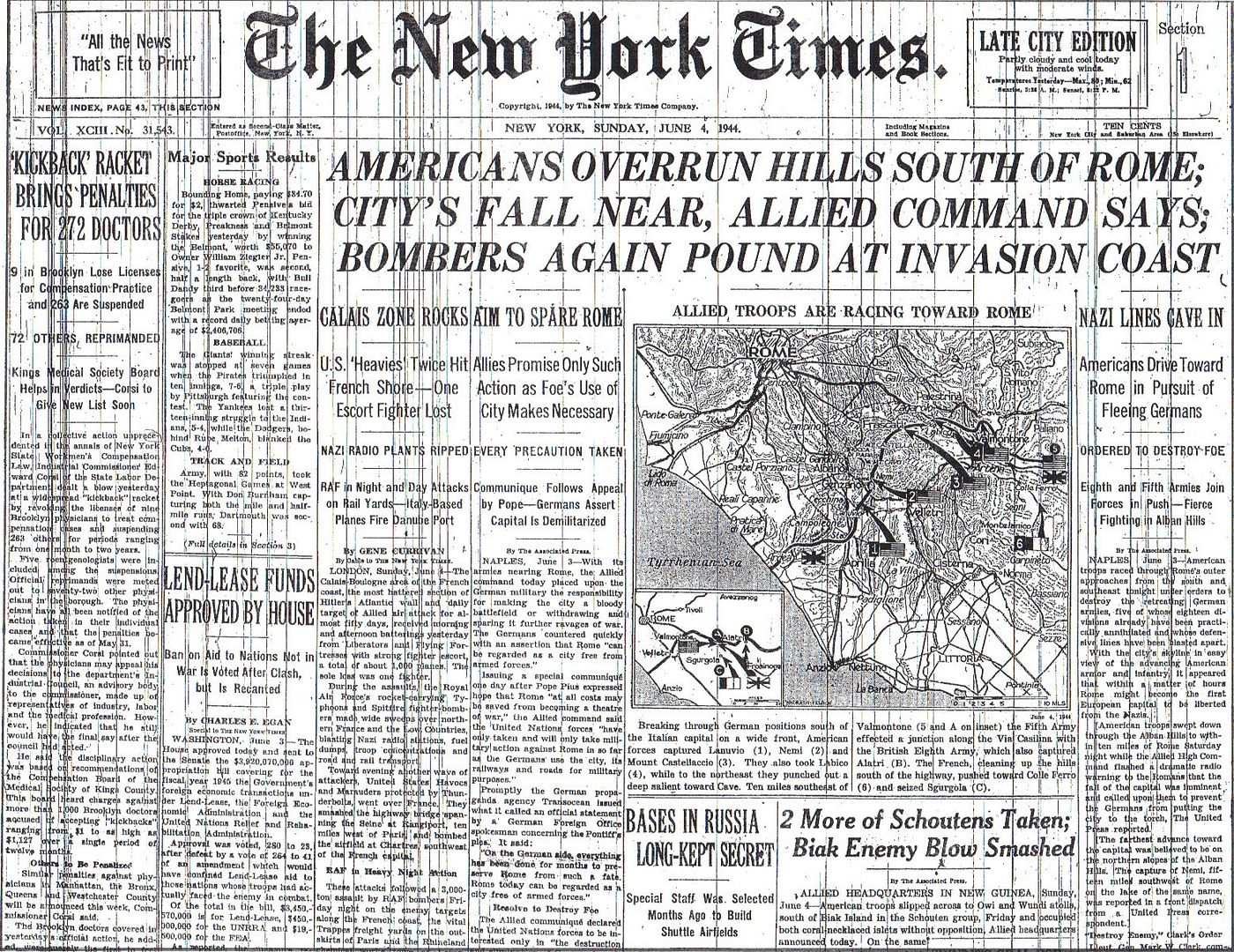
Posted on 06/04/2014 4:10:40 AM PDT by Homer_J_Simpson

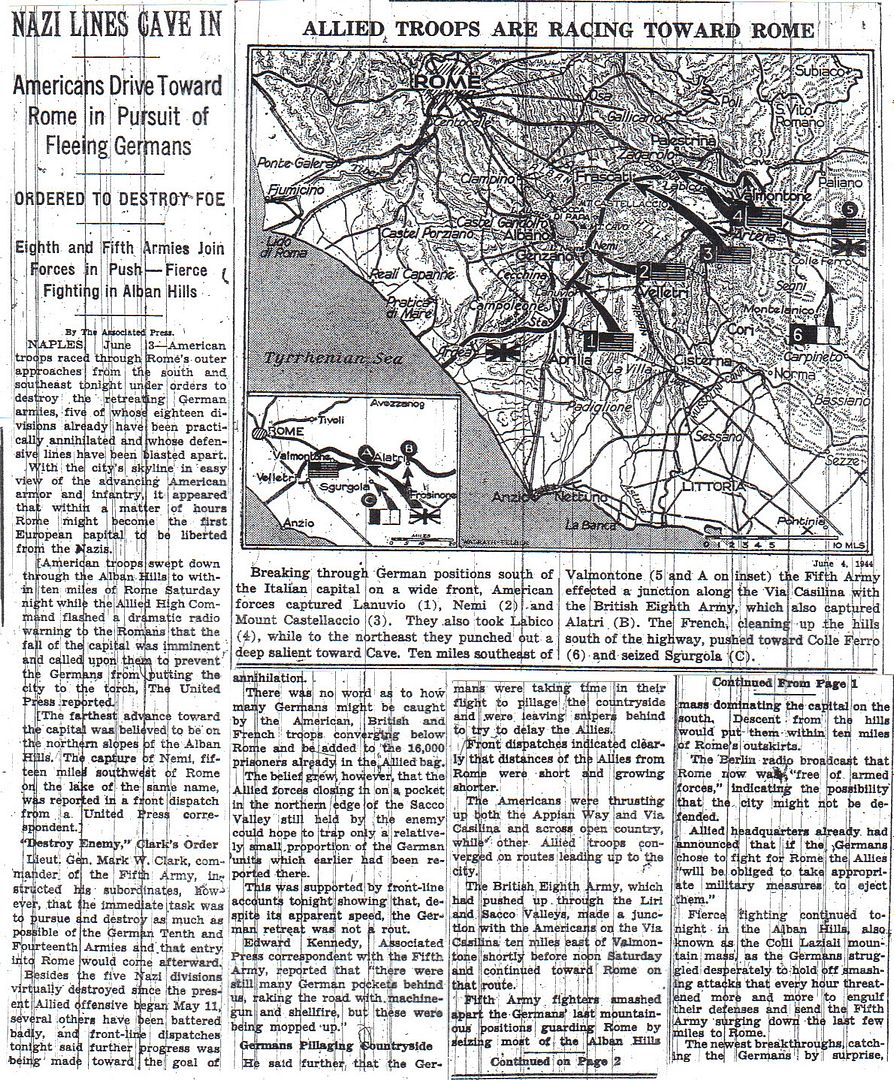
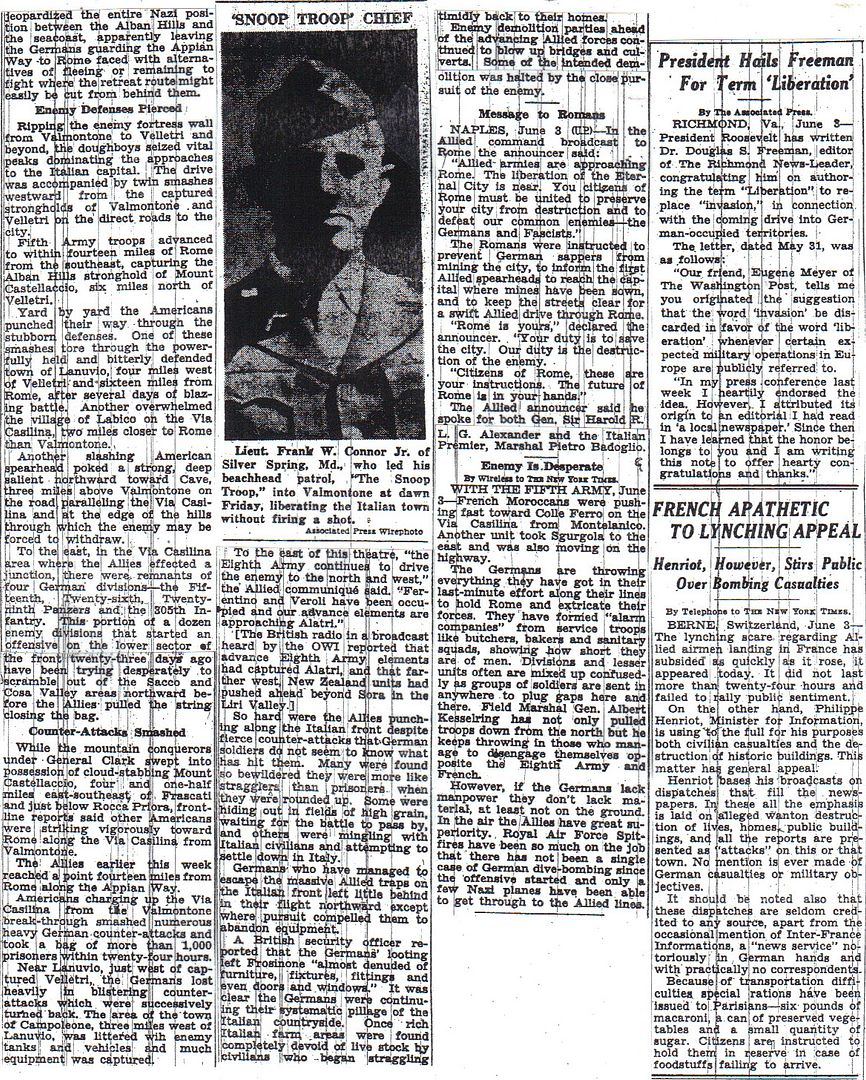
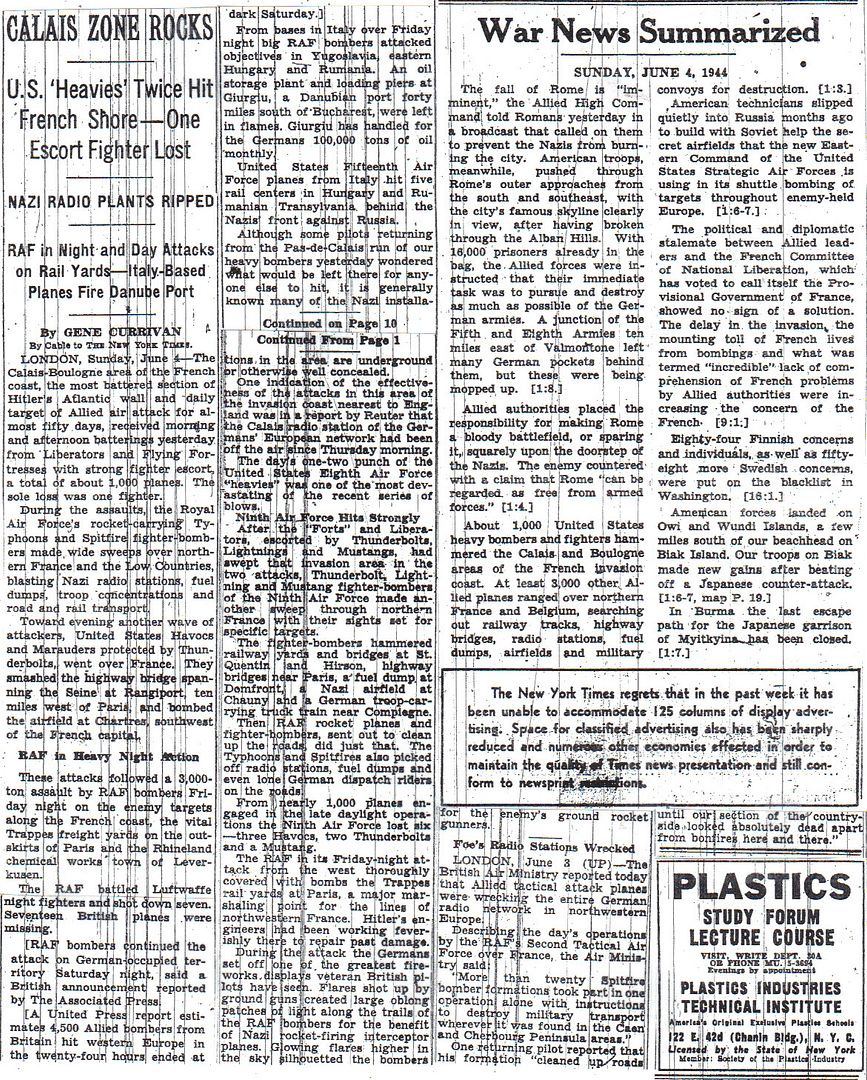
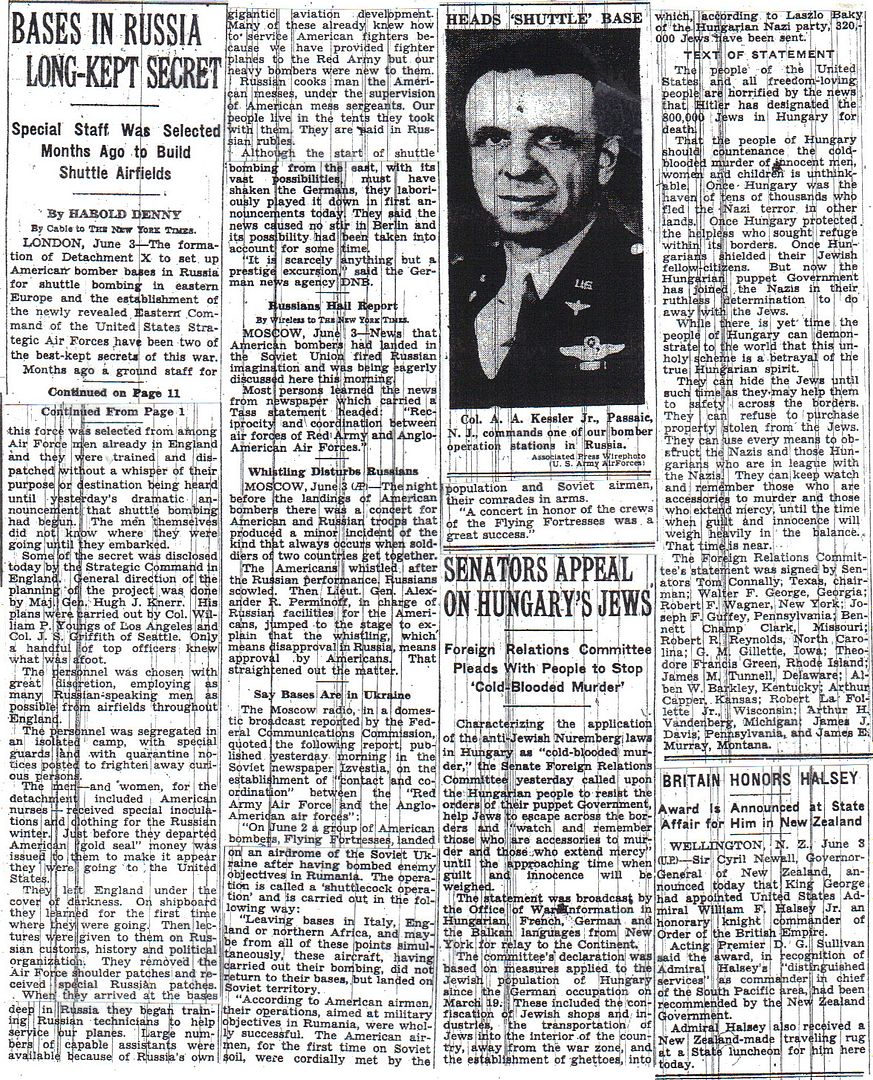
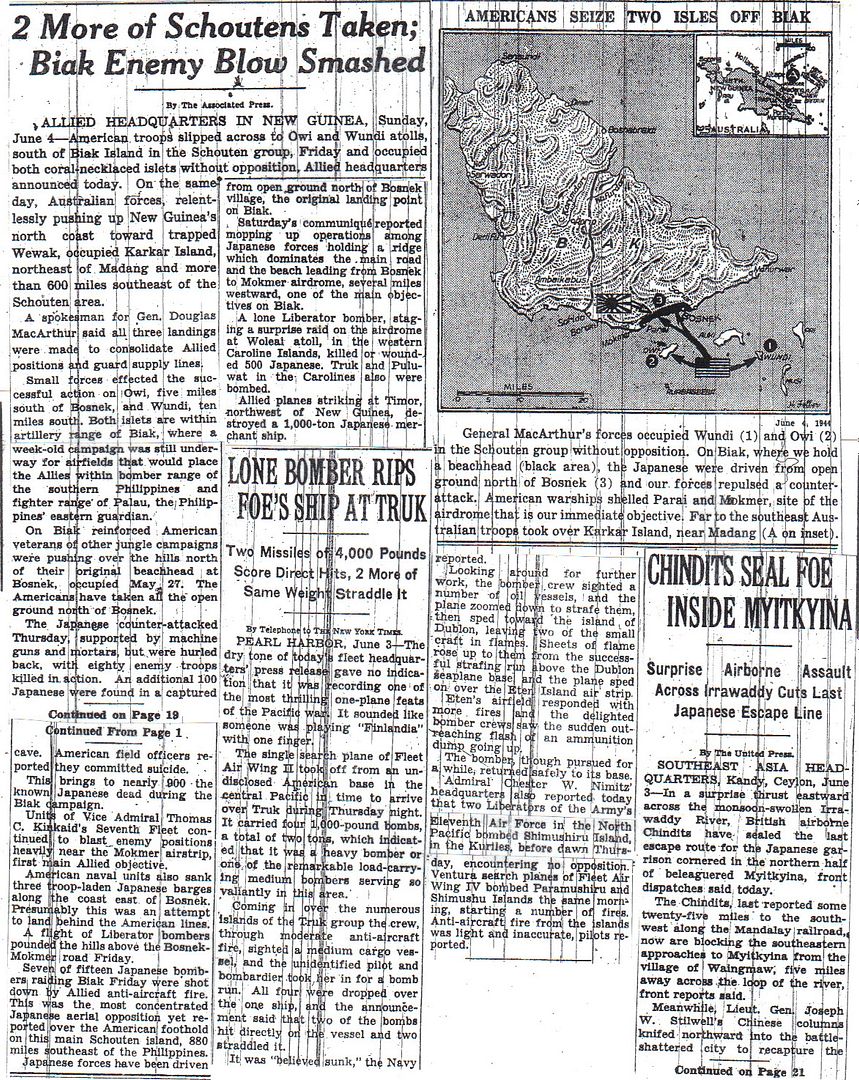
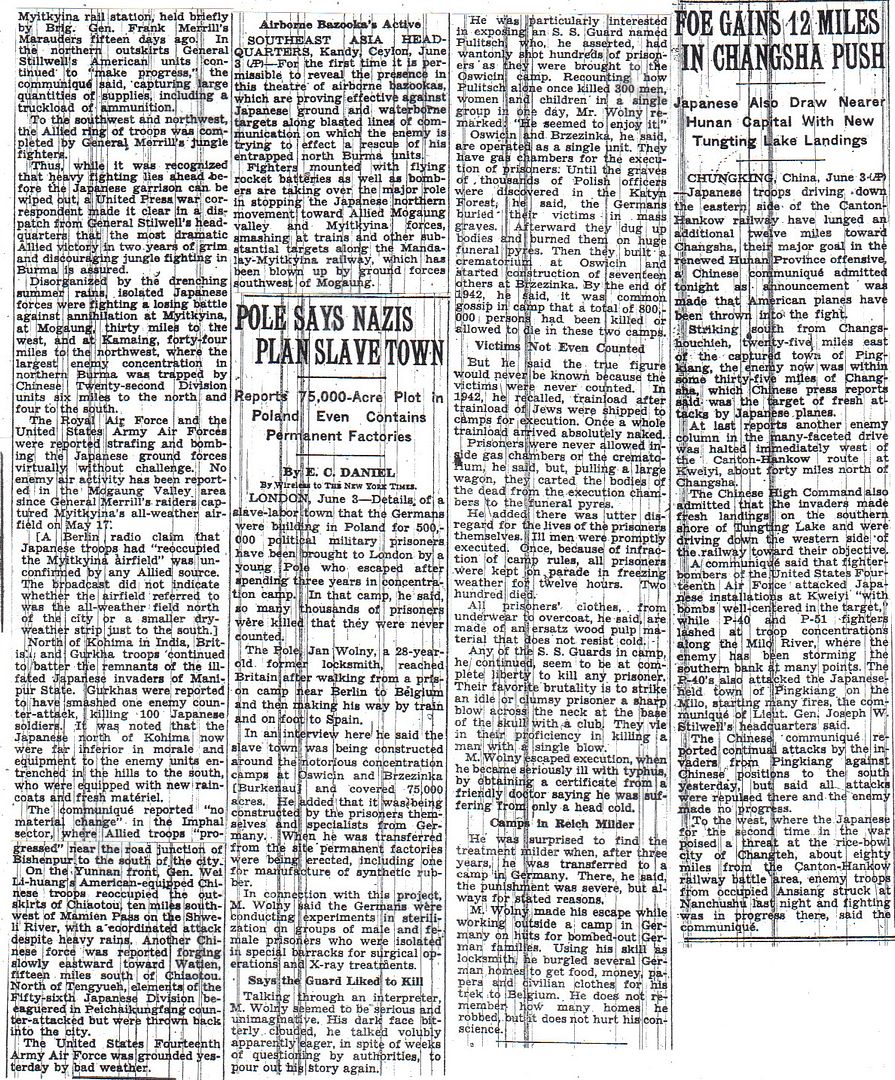
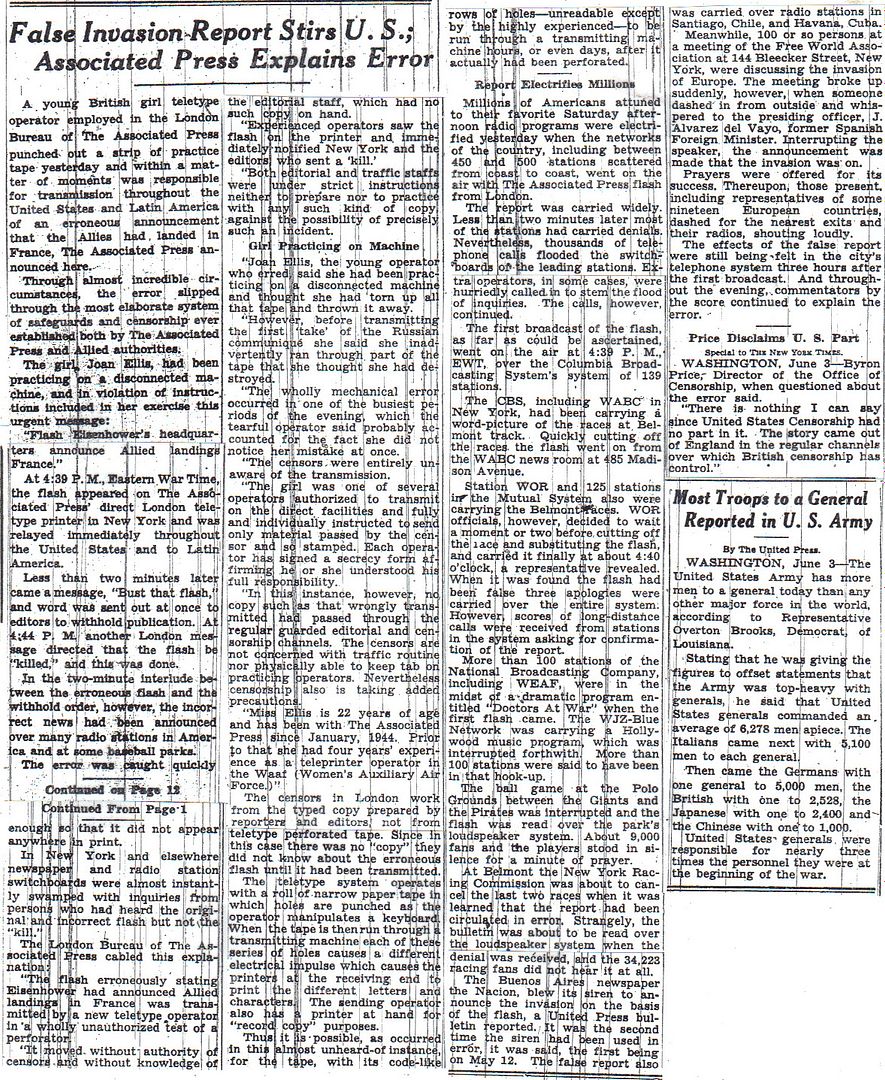

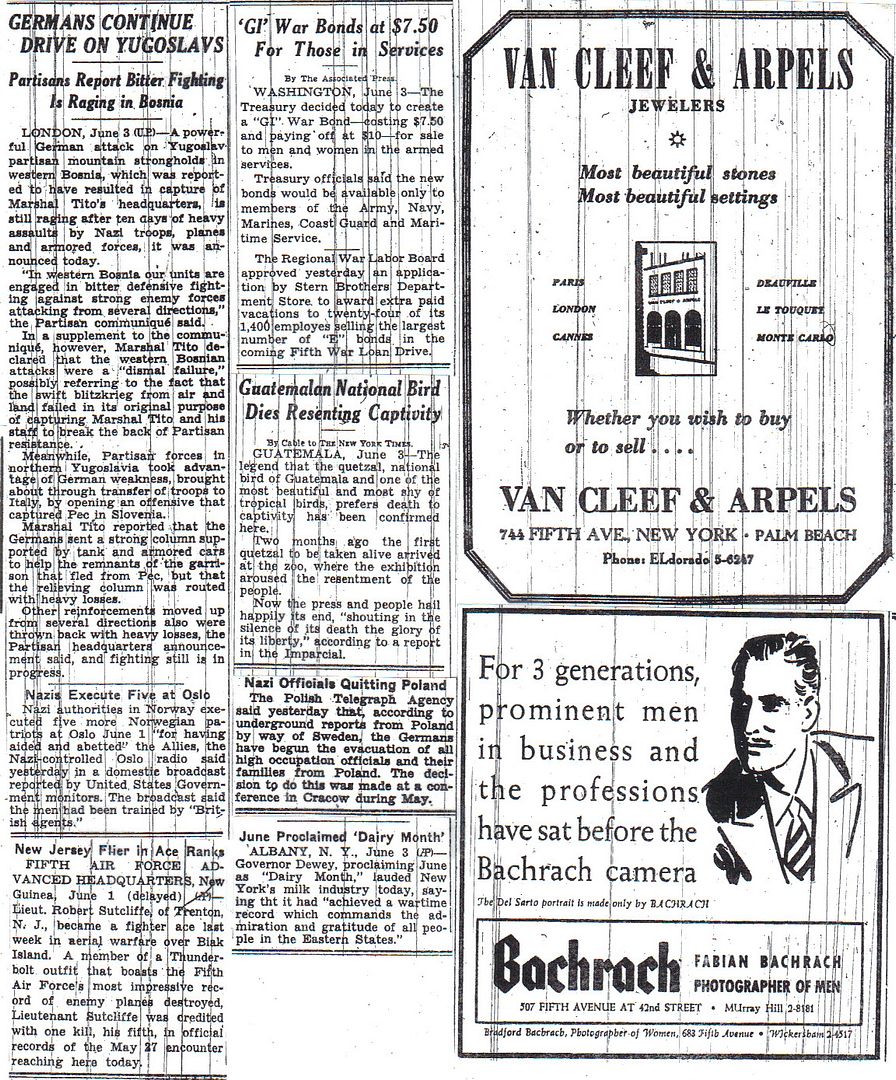
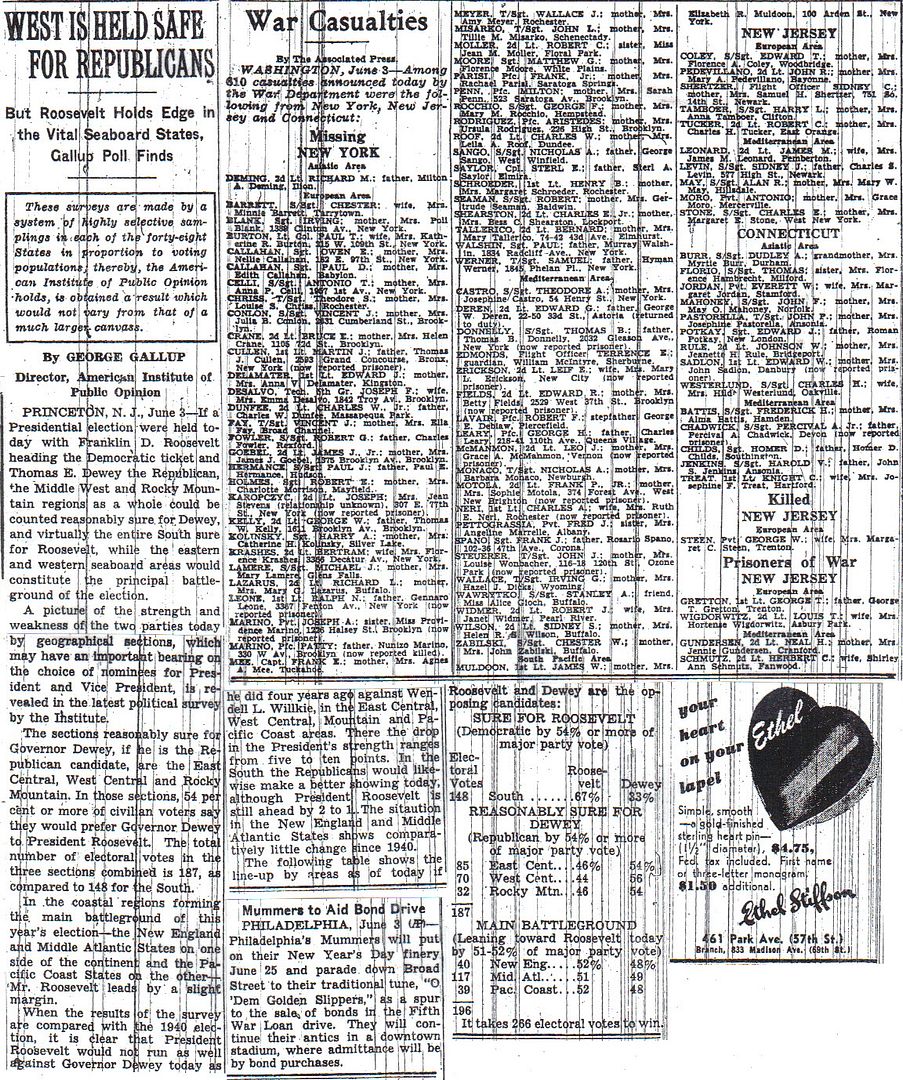
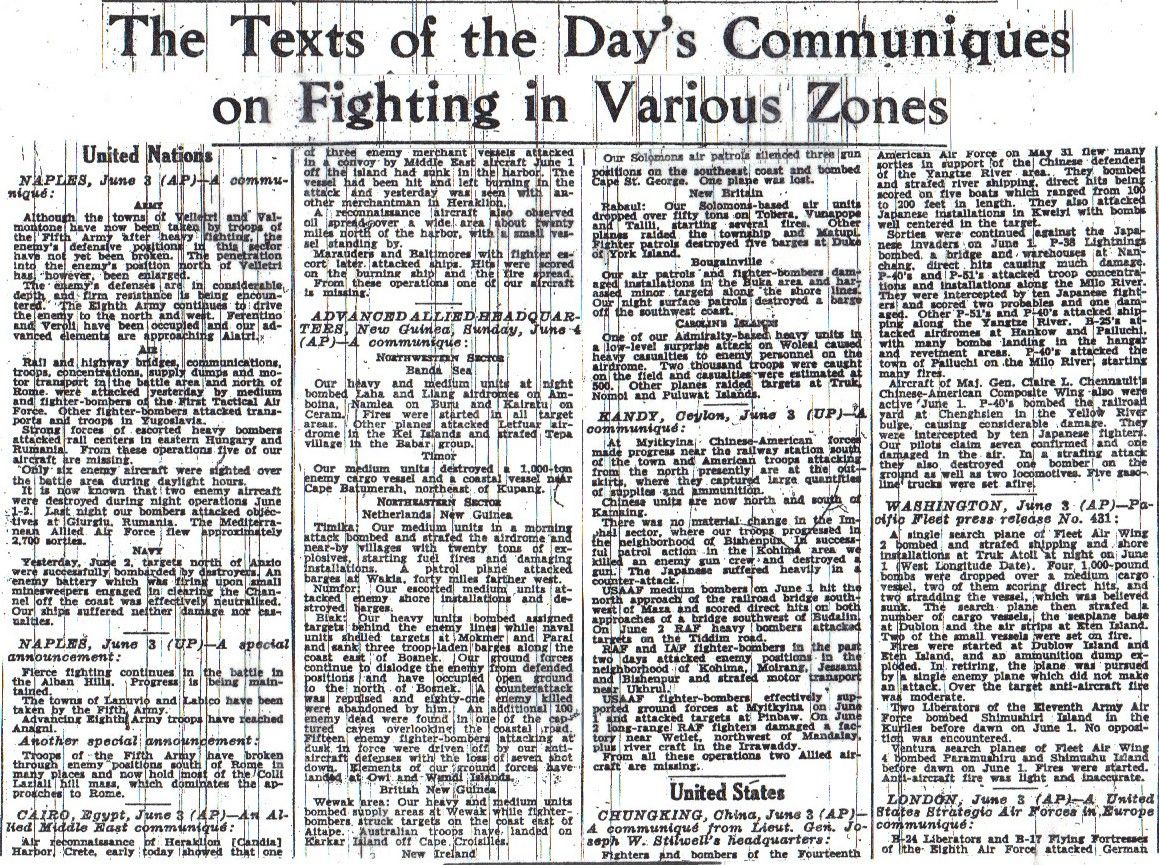
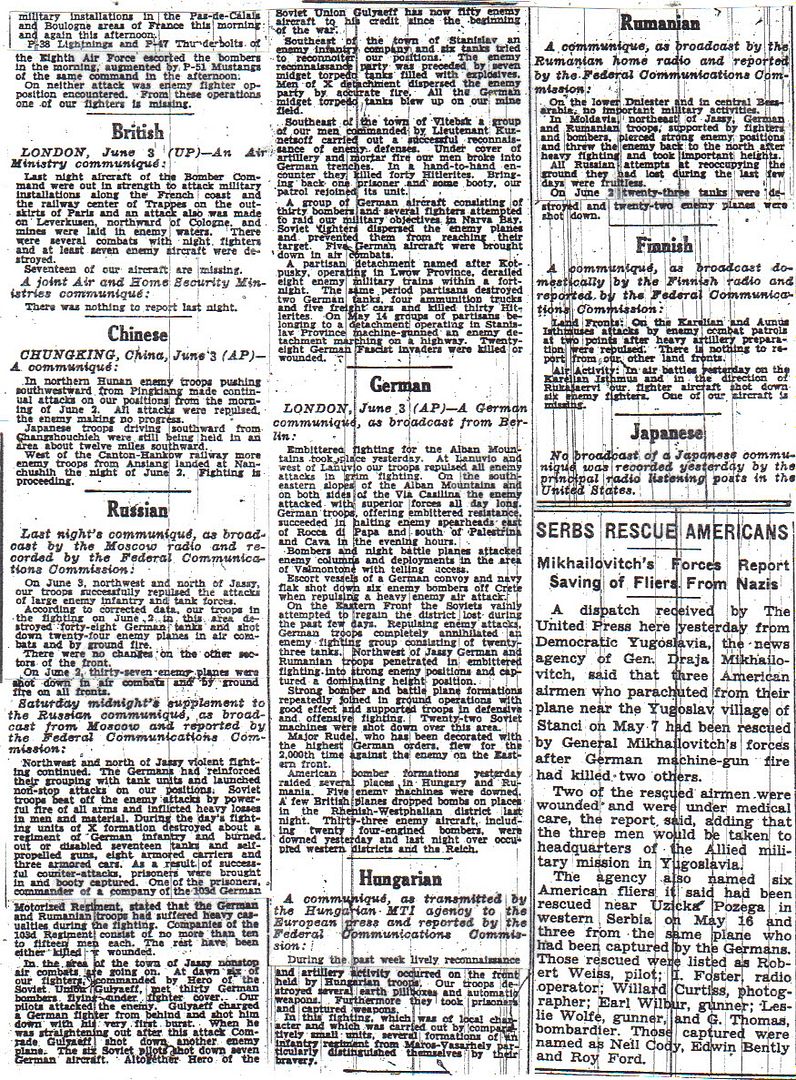
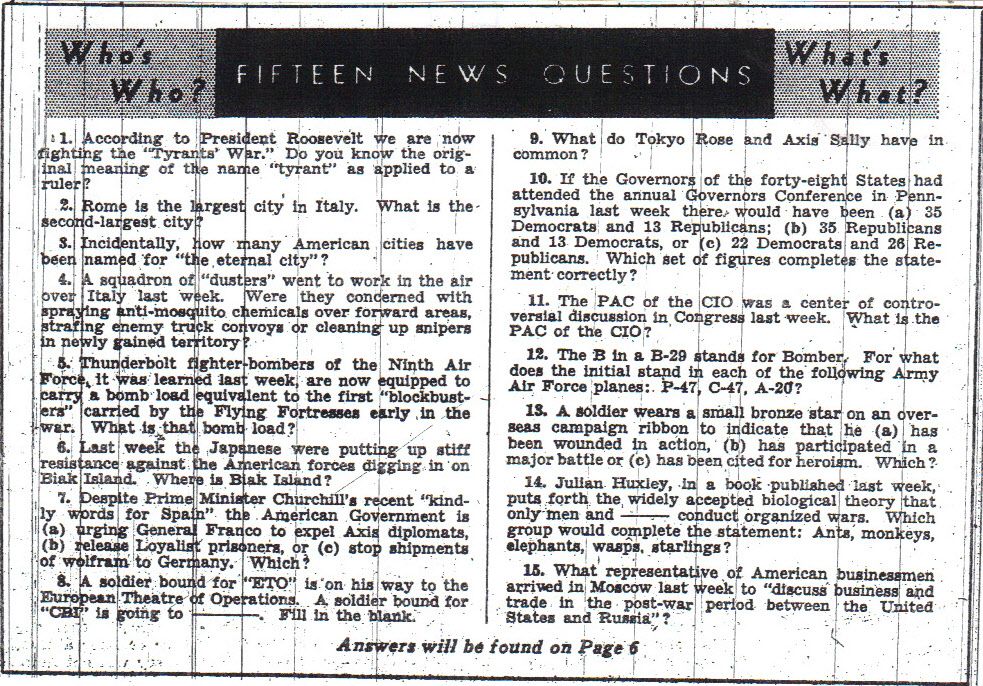
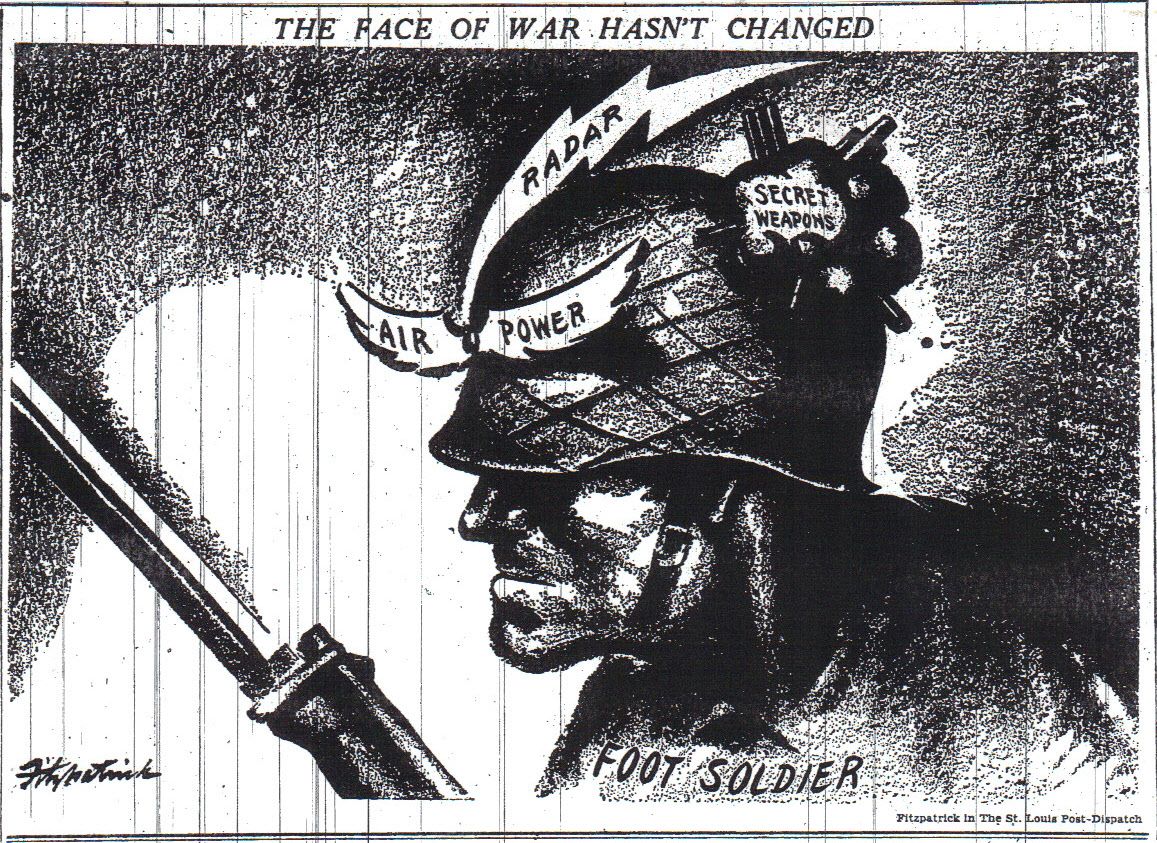
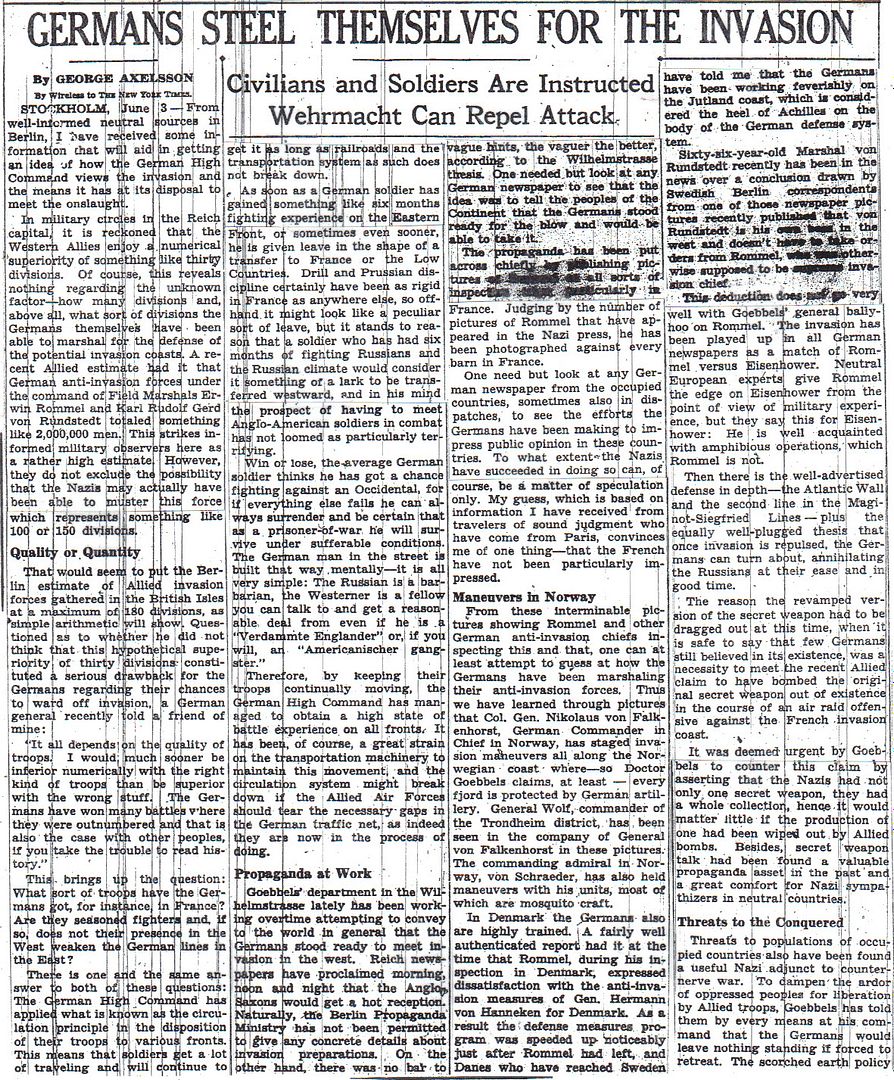
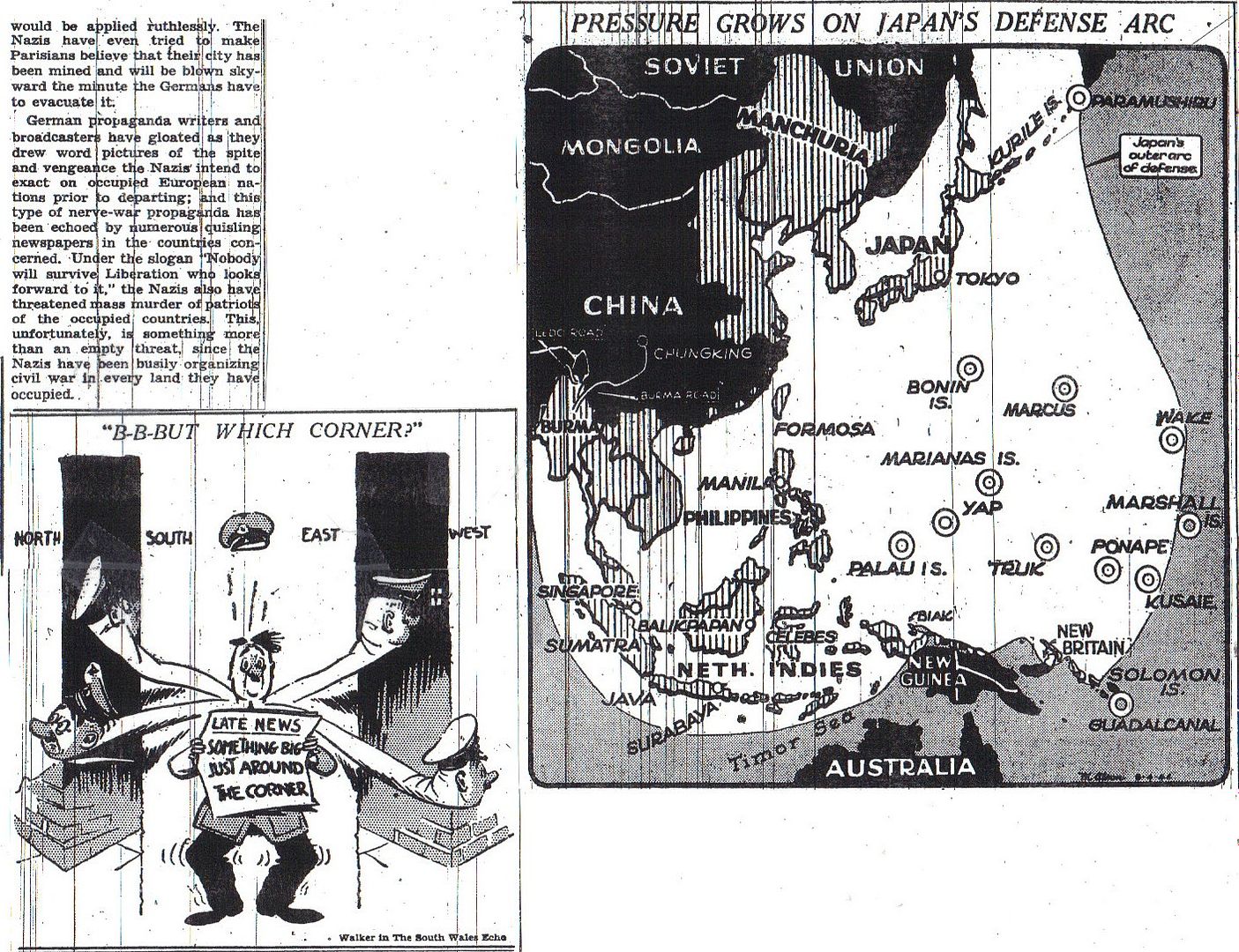
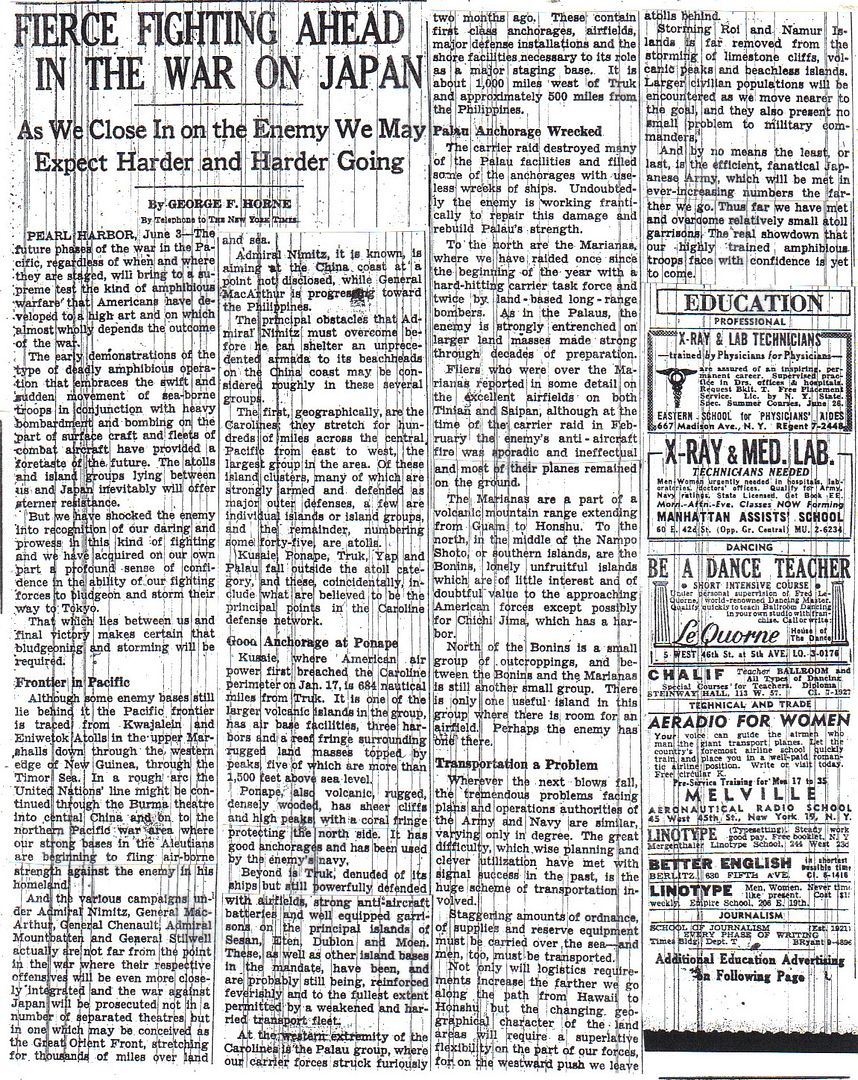
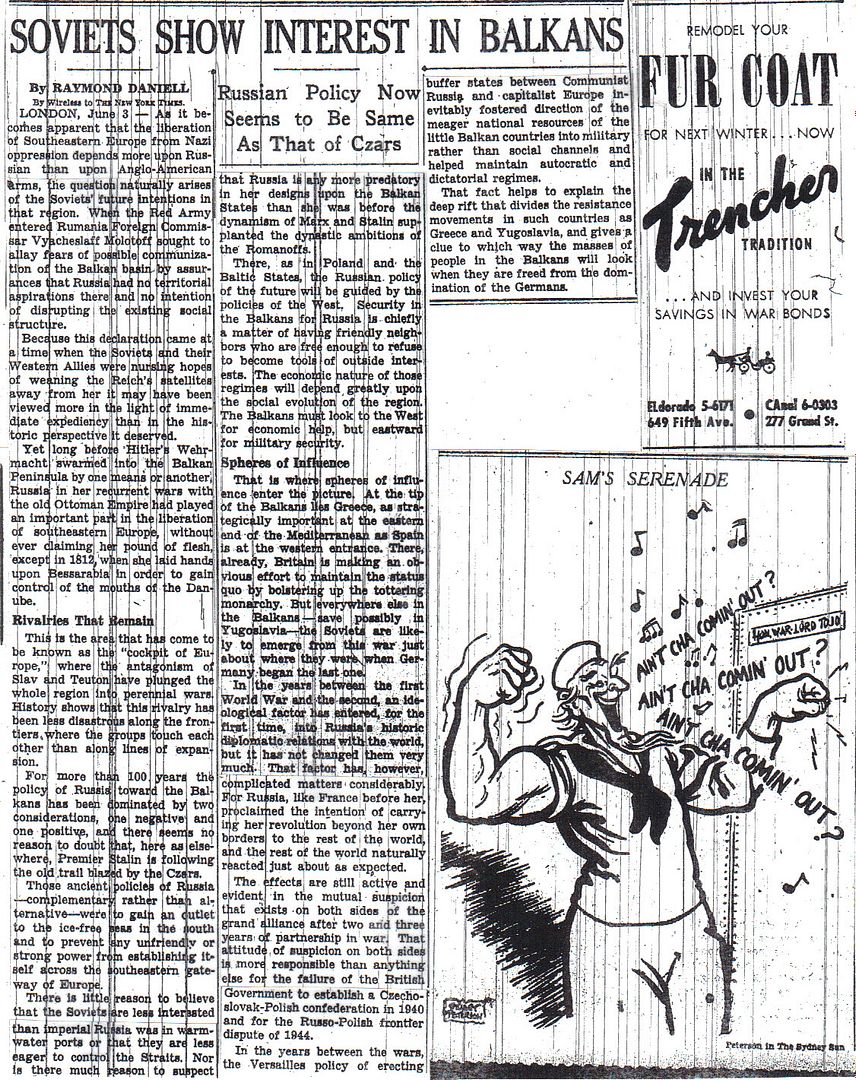
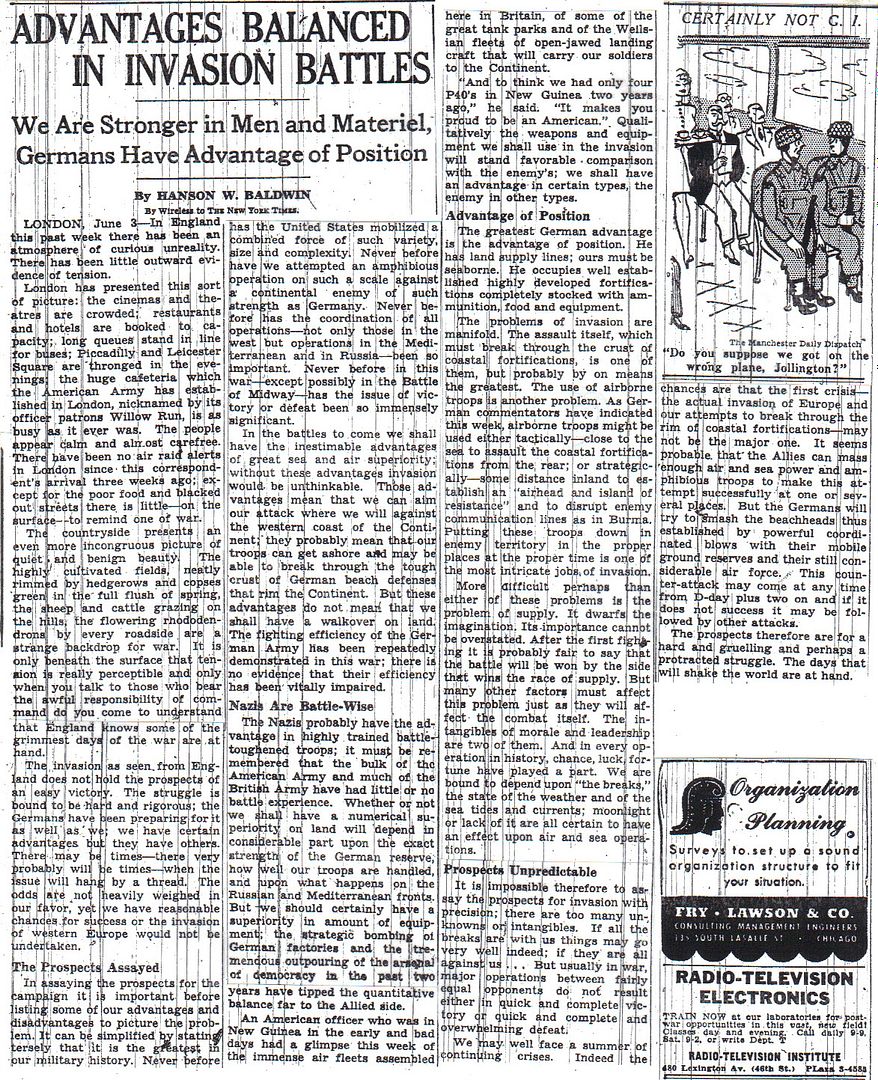
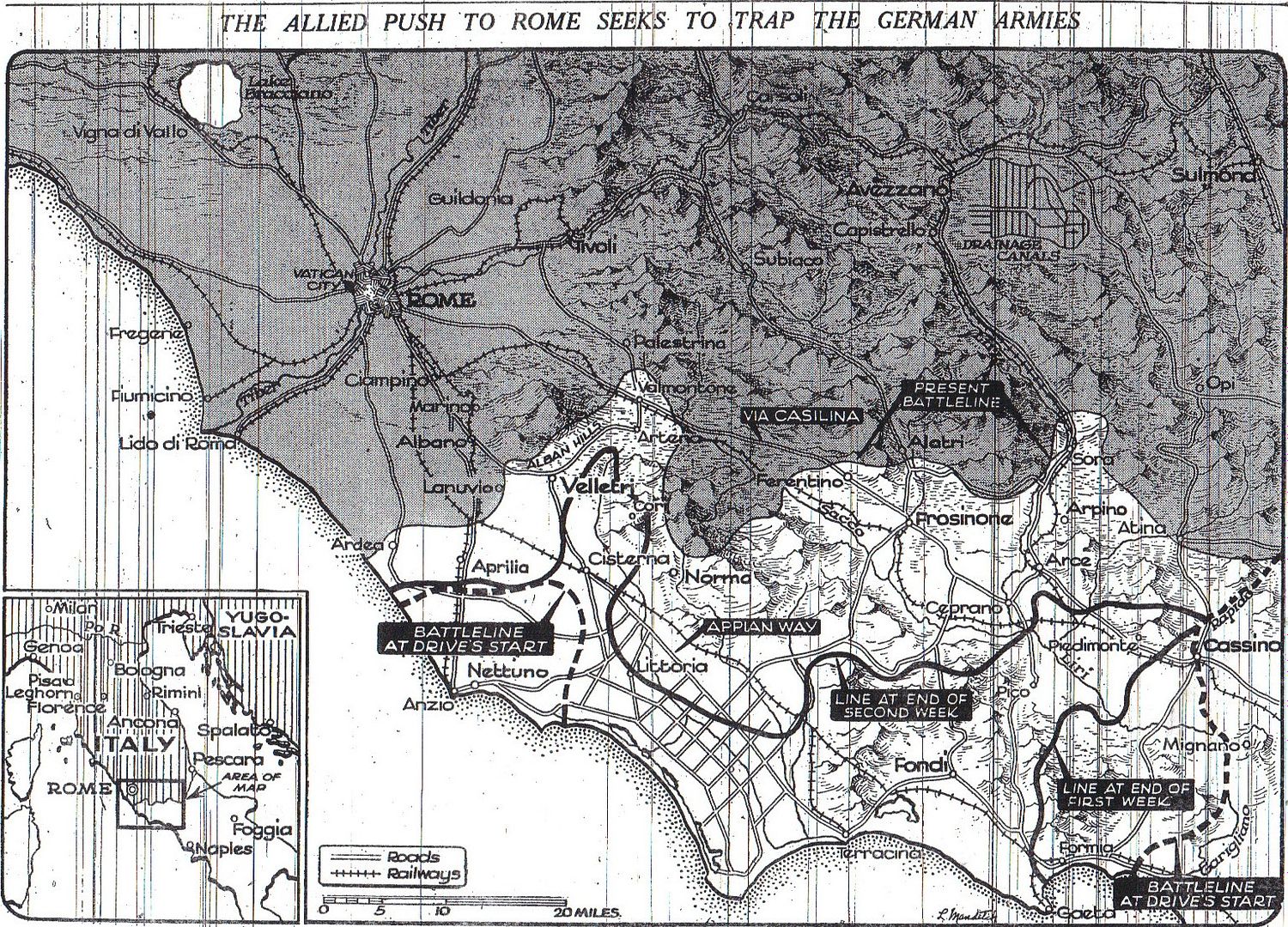
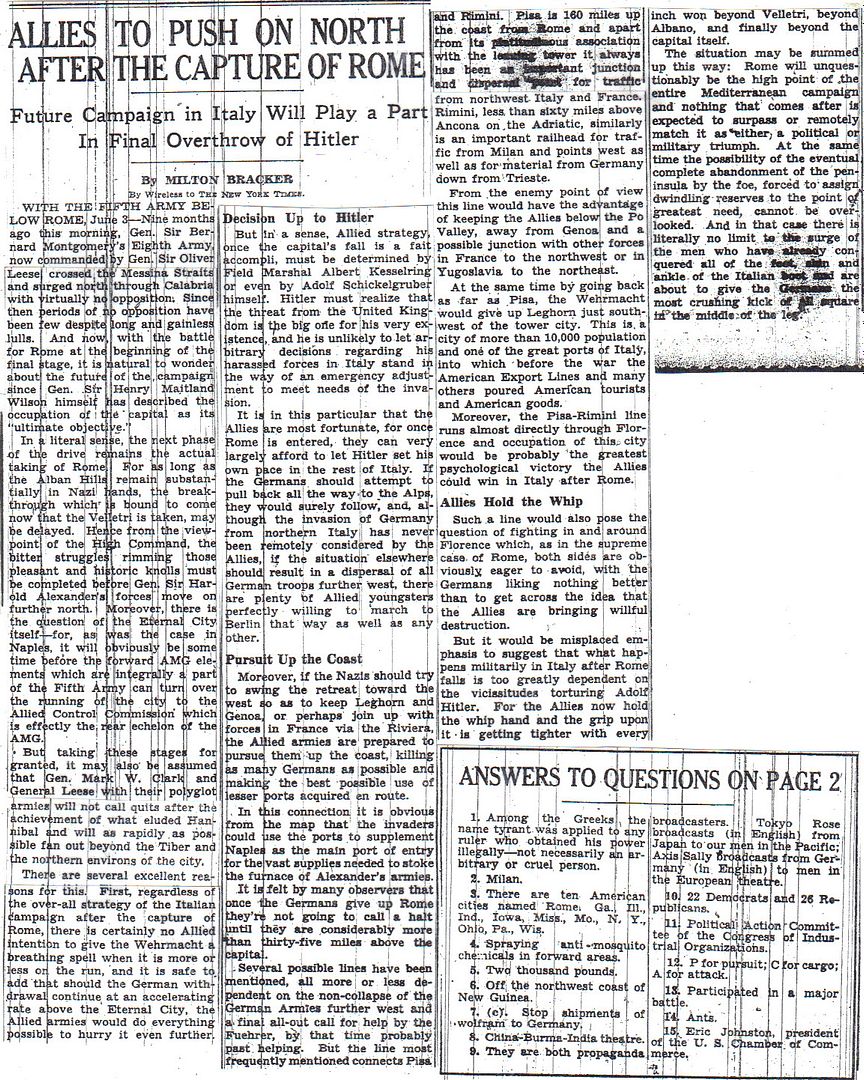
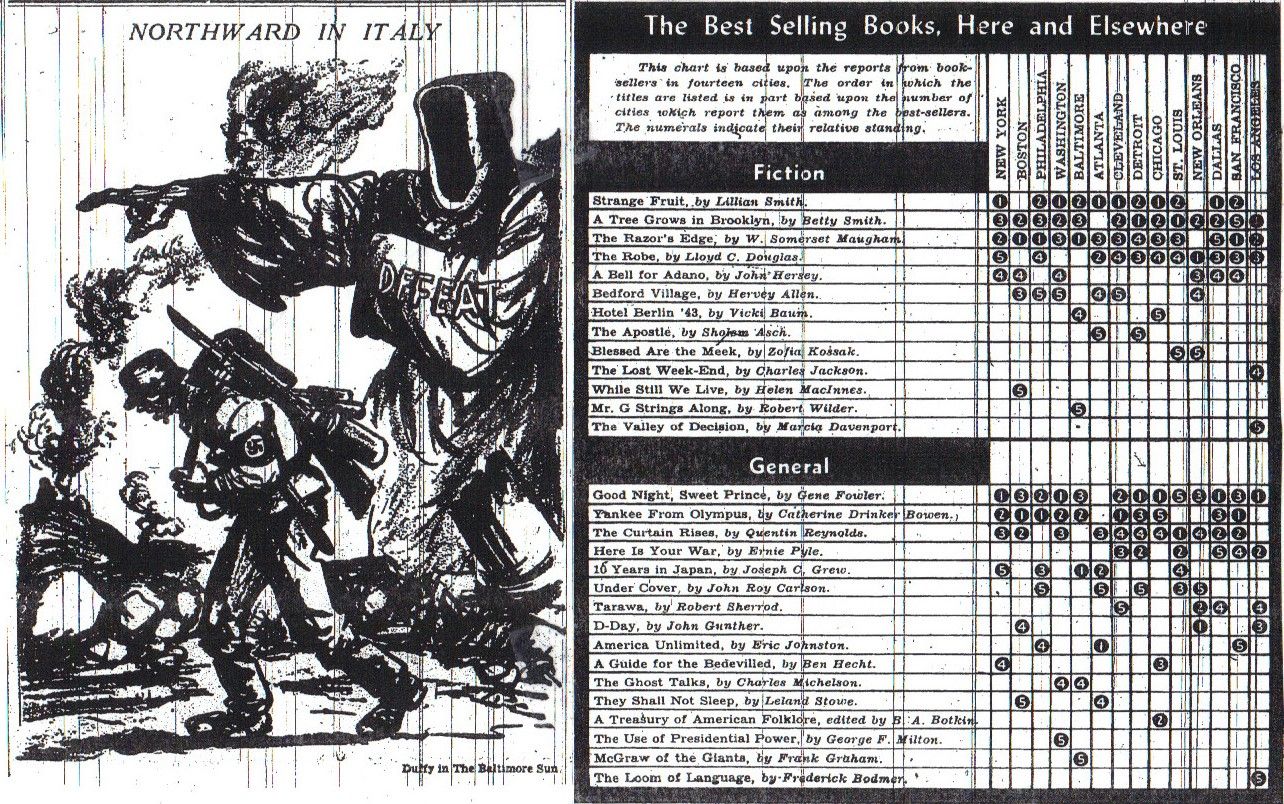
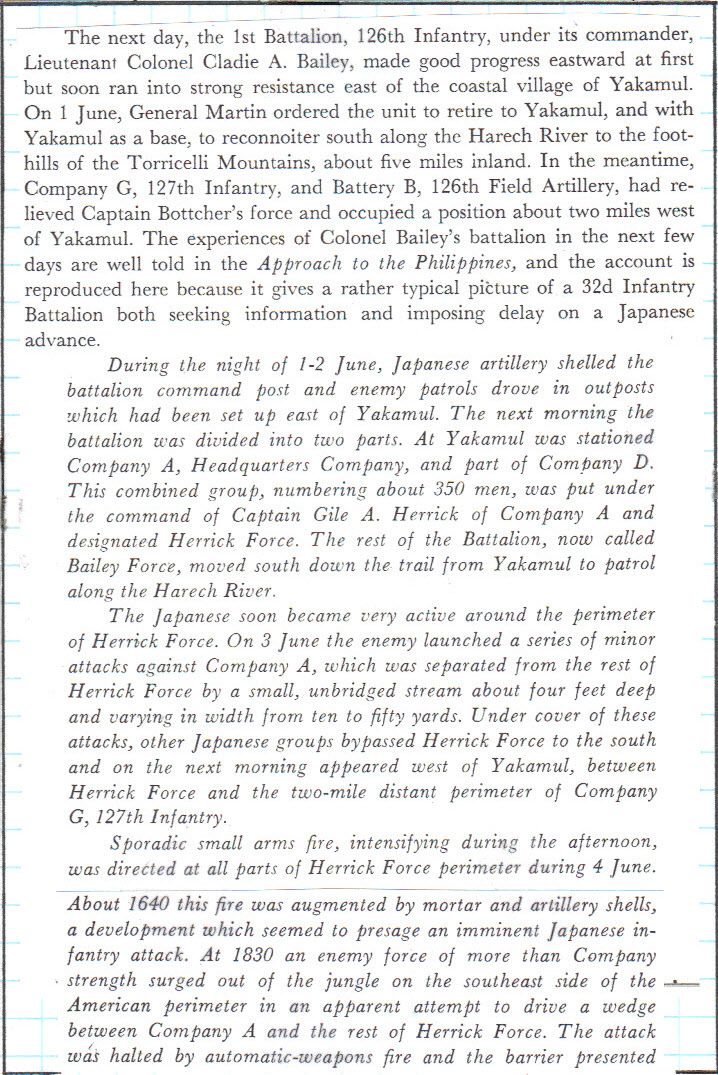
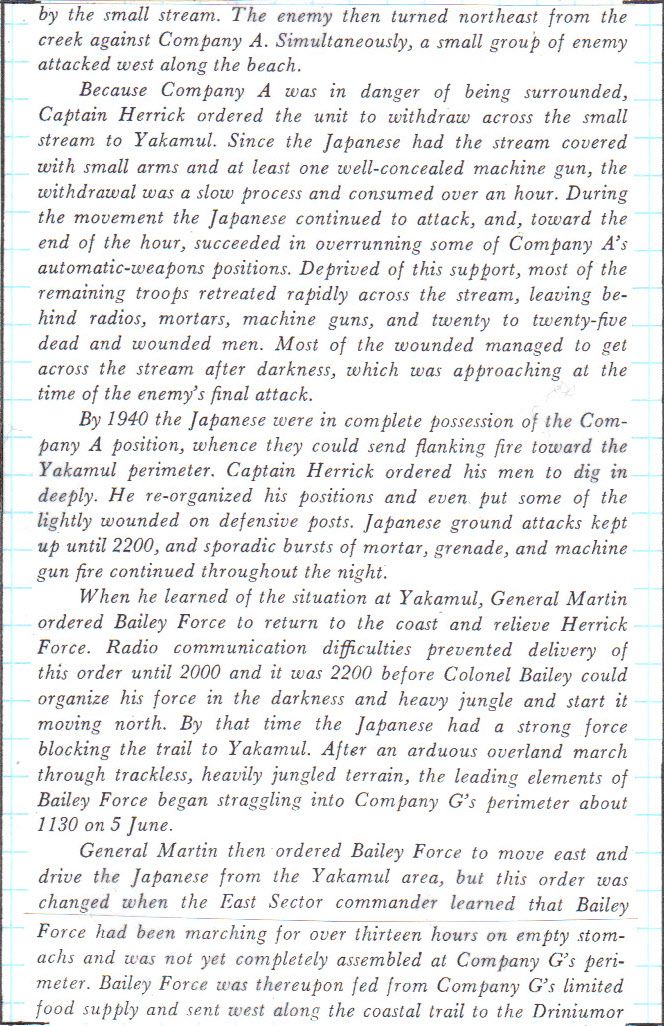
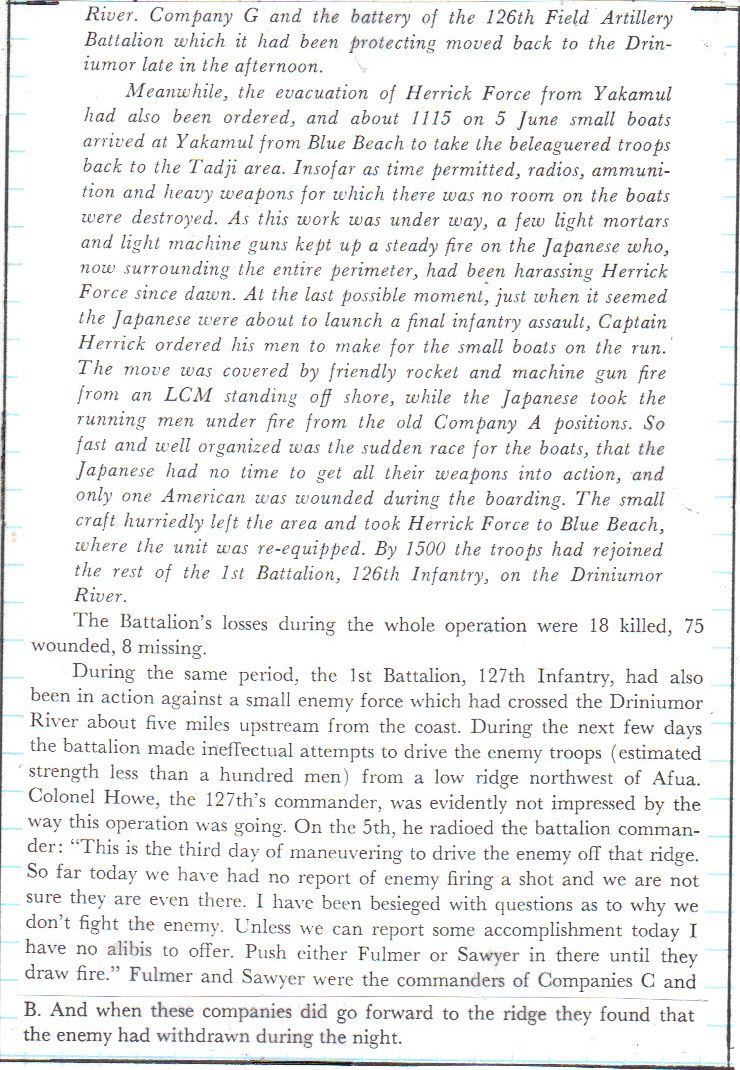
Major General H.W. Blakeley, USA, Ret., The 32d Infantry Division in World War II
The News of the Week in Review
Fifteen News Questions – 14
The Face of War Hasn’t Changed (cartoon) – 15
Germans Steel Themselves for the Invasion (Axelsson) – 16-17
Pressure Grows on Japan’s Defense Arc (map) – 17
Fierce Fighting Ahead in the War on Japan (Horne) – 18
Soviets Show Interest in Balkans (by Raymond Daniell) – 19
Advantages Balanced in Invasion Battles (by Hanson W. Baldwin) – 20
The Allied Push to Rome Seeks to Trap the German Armies (map) – 21
Allies to Push On North after the Capture of Rome (by Milton Bracker) – 22
Answers to Fifteen News Questions – 22
Northward in Italy (cartoon) – 23
The Best Selling Books, Here and Elsewhere (from Book Review) – 23
http://www.onwar.com/chrono/1944/jun44/04jun44.htm#
Americans liberate Rome
Sunday, June 4, 1944 www.onwar.com
Elements of the American 5th Army enter Rome [photo at link]
In Italy... Elements of the US 5th Army (Clark) reach Rome. In the evening, elements of the US 88th Division enter Rome.
From London... The Allied Expeditionary Force convoys, bound Normandy, are called back to port because of poor weather conditions expected for June 5th. Eisenhower decides, however, that the invasion can take place on June 6th. The poor weather has also encourage the German defenders in occupied France. Rommel, commanding Army Group B, decides to go to Germany for his wife’s birthday on June 6th and to meet with Hitler. Other German commanders in the Normandy area are at a training exercise in Brittany.
http://www.etherit.co.uk/month/thismonth/04.htm
June 4th, 1944 (SUNDAY)
UNITED KINGDOM: Late tonight General Eisenhower decides the invasion of Normandy is to go on June 6.
USS Susan B. Anthony, a attack transport, stands out to sea from Bristol. On board are elements of the 90th Infantry Division, VII Corps floating reserve for Utah Beach, and personnel of the 321st Glider Field Artillery Battalion, 101st Airborne Division. (Jay Stone)
The USAAF’s Eighth Air Force in England flies three mission to France.
In the first mission (Mission 389), the effort is to be divided between the Pas de Calais (COVER) area and the Normandy assault (NEPTUNE) area, however, D-Day is postponed 24 hours and the NEPTUNE force is cancelled. 183 of 201 B-17 Flying Fortresses and 51 of 56 B-24s attack seven targets in the Pas de Calais area; escorting are 130 P-47 Thunderbolts and 42 P-51 Mustangs; two P-51s are lost.
In the second mission (Mission 390) 222 of 246 B-17s and 53 of 68 B-24s bomb eight coastal defence positions in the same area using PFF.
The third mission consists of 263 B-17s and 185 B-24s hitting airfields, railway junctions and bridges; of the B-17s, 96 hit the Massey/Palaiseau railroad bridge, 50 hit the Versailles/Metelots railroad bridge and 34 hit the Villeneuve/St George railroad bridge; of the B-24s, 23 hit Brourges Airfield, 72 hit the Romorantin/Prunieres Airfield, 56 hit the Avord Airfield, 55 hit the Bretigny Airfield and eight hit the Melun bridges. Escort is 135 P-47s and 277 P-51s; they claim 1-0-0 Luftwaffe aircraft; one P-51 is lost.
Two B-17s fly weather reconnaissance over the UK and the Atlantic.
The USAAF’s Ninth Air Force in England dispatches 300+ B-26s and A-20 Havocs to bomb highway bridge and coastal batteries in France; almost 200 P-47s and P-51s dive-bomb bridges, railroad junction, rolling stock and targets of opportunity.
HMCS Orangeville departs Londonderry escorting convoy ONS.229
ENGLISH CHANNEL: Overlord convoys at sea turn back because of bad weather which is expected for tomorrow. The bad weather puts the Germans off guard.
FRANCE: Rommel leaves for Germany to see Hitler and celebrate his wife’s birthday.
D-Day Countdown The German Perspective Sunday, 4 June, 1944
It is the early morning hours. A fierce storm that came up the day before continues to rage across the channel. The invasion fleet, fighting its way through the howling winds and rough seas, struggles to make headway. If the invasion is to begin on schedule, they will have to make their way through crashing waves for another whole day before H-Hour comes on the morning of June 5th.
Eisenhower meets around 4:30 A.M. (DBST) with his staff. He is told that the weather is still too rough for a landing; the invasion must be postponed until conditions improve. At 5:15, Eisenhower, hoping that the weather might break, postpones the landings for 24 hours.
All Allied radar jamming operations are called off, so that those stations in the German naval radar network that are still up do not set off any alarms. At once the codeword `Ripcord 24’ is sent to the Allied fleet approaching the French coast in the heavy seas.
Most of the thousand ships immediately begin to turn back. Inevitably, as things often happen, some units do not receive the recall, and the Allies play hell getting them all to turn back. A force of minesweepers is only 35 miles from the beaches when they finally get the word. Another contingent of some 125 vessels, part of Force U (for Utah Beach) are a scant 26 miles from the Calvados coast before they are persuaded to turn around. At least one German radar station tracks them, but the crew relaxes their vigil when the massive blip turns back towards England. No alarm is given. The Allies are lucky.
At La Roche-Guyon, dawn is gray and misty. The town is still wet in the aftermath of the brutal storm that has also hit the Channel. Torrents of rain and heavy winds had ravaged the dry land. The worst of the storm for now has abated inland, and in the fog, the chateau stands like something out of a Poe story.
Field Marshal Rommel, bolstered in his mind by the bad weather, and reassure by the Luftwaffe official weather reports calling for more continued rain and winds, today makes what is considered one of the unluckiest decisions in his career.
He decides to go home. To get a quick rest before the main event begins, which looks like it is coming up.
After he eats an early breakfast and gives some last minute instructions to his chief of staff, he leaves for Germany. With him are his aide, Lang, and the Operations Officer, (now) -Oberst- von Tempelhof. Outside of their baggage and some papers, Rommel takes Lucie’s new shoes, and Lang takes a thermos of consumme and some small sandwiches. They leave at 0700 in two cars, one of course for Rommel, driven by Corporal Daniel, and the second* for von Tempelhoff, since his is in the shop at this time.
The trip is, for the most part, uneventful, except for a flat tire in Luneville. Rommel makes it home that night, tired and depressed. His wife and fifteen-year old son, Manfred try to cheer him up, including making his favorite Swabian dish, -Spaetzle mit Kalbsbraten-** They retire early.
The empty morning seems to drag on at La Roche-Guyon. The weather continues to be bad for the rest of the day. And with the field marshal gone, it is like a holiday routine. A couple of incoming calls deal with whether or not inland shipping should operate in the bad weather. Speidel dispatches a message to OKW, reporting that -Heeresgruppe B might stand down its two armies during the bad weather, so that they might get some rest after the low-grade alert they had been on for a while now. He also added that enemy air activities still indicated the Straits of Dover as the likeliest landing area.
Field Marshal von Rundstedt begins writing his weekly estimate to OKW that afternoon, but he quickly grows tired of it. Jotting most of the points down, he sets it aside. He and Blumentritt would finish it on Monday, the 5th.
Adolf Hitler is still enjoying the beautiful scenery of Obersaltzberg, with his headquarters staff situated at various locations around the town. In one of today’s meetings, he and Albert Speer discuss turning over aircraft armament production to Speer’s own War Ministry. Göring would be furious. Too bad. He isn’t exactly the Fuehrer’s favorite son these days.
Admiral Krancke at Naval Group West is finishing up his latest situation report. His available forces looked pathetic. Less than half a dozen fleet torpedo boats, some minesweeper flotillas, several score auxiliary craft, and his biggest punch, five squadrons of 100-ton E-boats.
On the positive side, the enemy bombings have not damaged his forces as badly as he had feared. His radar stations for instance, have not all been knocked out. Not by a long shot. And only eight naval guns have been put out of action -— some five in the -Kanalkueste-, and three in the Normandy area. He was sure that an invasion would not come until a widespread, aggressive bombing campaign was carried out against the coastal batteries. And that was just not happening.
The report’s summary accurately reflects Krancke’s views. If the invasion comes, it would probably be at the Pas de Calais - that’s IF it comes. He is seriously beginning to doubt that the invasion will take place at all=E2=80=A6 Well, at least not this year. The furor across the English Channel is starting to look like a gigantic, elaborate ruse, just to keep them armed along the French coast, and their divisions away from the other fronts where they would do some good. And the enemy might very well keep up this facade for many months yet, preparing all the while, while these sixty divisions just sat along the coast, and the Germans mean- while continued to lose on all the other fronts.
Eventually, they would get so weakened in the West from transfers to the other, threatened fronts, that an invasion here would be sure to succeed.
Yes, he could feel himself starting to relax. The enemy did not look like he was going to come soon. He glanced again at the meteorological eport. And especially not in bad weather.
Krancke issues one last set of orders before he departs for Bordeaux (to wind up some mining operations in the Bay of Biscay). Because the weather i scheduled to be bad for the next few days he i suspending minelaying operations. After hesitating, he decidesto add naval patrols to the order. After all, there will be nothing out there to see, and why risk losing an E-boat? He had damned few left as it is.
9:30 P.M., (DBST). Eisenhower, dressed as always in his olive green battle dress uniform, walks into the library of Southwick Manor. He and his staff must decide whether to give the word to start Operation Neptune, or to delay the invasion again, this time to at least mid- late June, or maybe even mid-July.
Chief meteorologist Staggs starts off by reporting that if the invasion had taken place on the 5th, it would have been a total catastrophe. He then delivers the good news that electrifies the tension in the room; an upcoming 3-day period of barely tolerable conditions is still scheduled to arrive early in the morning, and at the moment appears to be on track. The rain would subside, and the 25-30 knot winds would abate some. Clouds would be heavy, but not continuous. And by Tuesday morning, visibility should be good enough to allow naval fire support to spot their targets.
Eisenhower is faced with a tremendous decision. Another postponement now could easily spell disaster. The next tolerable tidal period would start on June 19th; but it would be moonless. To wait until July would add enormous security risks in keeping the time and place of the invasion secret, not to mention giving the enemy more precious time to prepare.
On the other hand, there is no promise that this short break in the weather would last. To make matters worse, postponing the invasion by 24 hours has meant that, should he give the word to go on the 6th, low tide would occur about an hour later, coming now at 5:15. The U.S. landings would therefore be at least an hour later, coming between 06:15 and 06:45 DBST.
An intercepted `Ultra’ message gives the Allies the latest Luftwaffe weather report, which calls for more bad weather, This confirms the fact that the Germans will not be looking for an invasion at this time.
Admiral Ramsay breaks into the debate with a time concern. If they are going to go on the 6th, some units will have to be notified within the next half hour. It is because of refueling considerations, Ramsay explains. If these forces sail any later, and are recalled, they would not be able to return and be refueled for a possible landing on Wednes- day, the 7th.
Eisenhower turns to each of his commanders one by one, and gets their opinions. They discuss it some more.
The room finally falls still as Eisenhower, sitting with his hands clasped, stares down at the green baize table. The silence stretches as the men look at him, waiting for his historic decision.
At 9:45 P.M., he makes it. Still staring at the table, he slowly says, “I am quite positive we must give the order... I don’t like it - but there it is.” Looking up to the men, he concludes, “I don’t see how we can possibly do anything else.”
Despite weather predictions for only minimal conditions and only for a small 2-day time period, he has reluc- tantly given the word that they will go on the morning of the 6th. They will have a final commanders meeting at 0400. That will be the last chance they have to break off the operation.
* Driven by an army sergeant.
** Veal stew with noodles.
*** Many sources have indicated that the Allies (specifically, the Americans) hit the beaches exactly at low tide. This is not the case. The first waves of Americans came ashore at or near 06:30, DBST. According to data taken from the English Channel Handbook prepared by the British Admiralty and included with U.S. all Navy operational orders, low tide for June 6th at St.-Vaast-la-Hougue (north of Utah Beach) was to be at 0504 hours and again at 1728 hours (GMT, which was on BDST). High tide was to occur at 1004 and 2240 hours. At Port-en-Bessin (east of Omaha Beach), these figures respectively were 0521 hours and 1745 hours for low tide, and 1036 and 2257 hours for high tide. Thus, extra- polating, low tide on Utah Beach would be about 0512, and about 05:18 for Omaha Beach. Low tide at the British beaches would occur around 05:26.
Pete Margaritis
ITALY: The US 88th Division enters Rome.
Rome was still in darkness early today when the first American Jeeps made their cautious way across the Tiber and along the Via di Conciliazone to St. Peter’s Square. It was not until the square was bathed by the morning sun that the Americans could be sure that the Eternal City had been left unscathed by the Germans.
The first of the three major Axis capitals has thus fallen. Even as the US Fifth Army began to pour into Rome in huge numbers, the last Germans were fighting rearguard actions in the suburbs; but the great bulk of Kesselring’s men are heading north to new defence lines, pursued by advance elements of the British Eighth Army.
It was not long before two million overjoyed Romans flooded into the streets, turning the arrival of the Americans into a glorious carnival. Every American vehicle was strewn with flowers, the passengers kissed and hugged and presented with bottles of Chianti.
The wait had been agonising. No one knew whether the Germans would wreak a savage revenge here as they had in Naples last October. The occupiers had declared Rome an open city, but no one, particularly the Allies, really believed them. Now the Germans are being pounded by continuous air attacks by 500 heavy bombers as they retreat towards Siena.
But this was Rome’s day. Three huge flags - Italian, British and American - hang from the Campidoglio [town hall] where Lieutenant-General Mark Clark and his colleagues received frenzied acclamation from the huge crowds. In St. Peter’s Square, the crowd was silent long enough to hear the Pope say: “Yesterday Rome was trembling for her sons and daughters. Today she is able to look with renewed hope and faith for her salvation.”
The Germans are likely to make the most of leaving Rome intact. Already Berlin radio is describing Hitler as “the saviour of the Eternal City”, and claiming that Rome had no strategic value. The Allies have yet to be led to the caves near the city where the bodies of 336 hostages were hurled by their SS executioners.
The USAAF’s Fifteenth Air Force in Italy dispatches 550+ B-17s and B-24s to attack communications in northwestern Italy and on both sides of the Franco-Italian frontier. In France, B-17s hit the Antheor railroad viaduct and Var River railroad bridges. In Italy, B-24s hit the marshalling yards at Genoa, Turin, Savona and Novi Ligure, the viaduct at Recco, and the railroad bridges at Orelle and Gad. Fighters fly 200+ sorties in support of the heavy bombers.
PACIFIC OCEAN:
CINCPAC PRESS RELEASE NO. 432, Shimushu and Paramushiru Islands in the Kuriles were bombed by Ventura search planes of Fleet Air Wing Four before dawn on June 2 (West Longitude Date). Two large fires were started on Shimushu. Antiaircraft fire was moderate. Matsuwa Island was bombed by Liberators of the Eleventh Army Air Force before dawn on June 2. No opposition was encountered. All of our planes returned.
Truk Atoll was bombed by Seventh Army Air Force Liberators before dawn on June 3. Forty-one tons of bombs were dropped on storage areas and on runways. Several fires and explosions were observed. Antiaircraft fire was meagre. Two enemy fighters attempted to attack our force but did no damage.
Nauru Island was bombed by Seventh Army Air Force Mitchell bombers and search Venturas of Fleet Air Wing Two on June 2.
Antiaircraft batteries were hit and fires Started. Antiaircraft fire was moderate.
Ponape Island was bombed by Seventh Army Air Force Mitchells on June 1. An airfield, hangars, and adjacent buildings were hit. No antiaircraft fire was encountered.
Remaining enemy objectives in the Marshalls were attacked by Ventura search planes of Fleet Air Wing Two, Dauntless dive bombers and Corsair fighters of the Fourth Marine Aircraft Wing, and Navy Hellcat fighters on May 31 and on June 1 and 2. In these raids antiaircraft batteries, coastal defence guns, runways and barracks were strafed and bombed. Antiaircraft fire was generally meagre. (Denis Peck)
ATLANTIC OCEAN: U-505 is captured. (Todd Ristau)
US Navy Task Force 22.3 consisting of the escort aircraft carrier USS Guadalcanal (CVE-60), with Composite Squadron Eight (VC-8) aboard, and destroyers escorts USS Chatelain (DE-149), USS Flaherty (DE-135), USS Jenks (DE-665), USS Pillsbury (DE-133) and USS Pope (DE-134) attack the German U-Boat U-505 in the South Atlantic. Directed by VC-8 TBM Avengers, the Chatelain drops depth charges, one of which blasts a hole in the outer hull of the submarine and rolled the U-boat on its beam ends. The inexperienced U-Boat captain thought his ship was sinking so he surfaced. The US commander of this task force, Captain Daniel V. Gallery, USN, had been planning for an opportunity to board a submarine and capture all the documents and boarding parties had been trained and equipped. A boarding party from Pillsbury was ordered to the submarine and found it abandoned.
The men of the boarding party went below seizing all papers and books and closing valves and stopping leaks. By this time, a larger boarding party arrived from Guadalcanal and after securing a tow line and rescuing the Germans from the water, the Guadalcanal took U-505 in tow. For their action, the crews of the six ships were awarded a Presidential Unit Citation. Not only Enigma codes, but also the Zaunkonig acoustic torpedoes were recovered. The original plan was to tow the U-boat to Dakar, but this is thought to be full of spies and so she will be taken to Bermuda instead. [U-505 is currently on display at the Museum of Science and Industry in Chicago, Illinois, USA.]
Extract from Jim Verdolini’s diary:
June 4, 1944.
U.S.S. Guadalcanal CVE60
1110 hours
I was in CIC( combat information center), when suddenly the DE Chatelain, came over the squawk box, “ Bluejay ,(that was us), this is Frenchy(Chatelain).
They had a possible sound contact. That means close by. We went to GQ, but the hatch was open, and we could see out to starboard. We tried to get out of the area. As Capt. Gallery said, “ A carrier in the middle of a sound contact, is like an old lady in the middle of a bar room brawl.” We could see the Chatelain, with the Pillsbury and Jenks. The Chatelain started dropping hedgehogs. Suddenly we saw our planes start to strafe the area where the hedgehogs were dropped. The sub started to surface, at 1121.
Our destroyers cut loose with machine guns, 20 mm and 40 mm. Capt Gallery yelled over the squawk box to the destroyers, “ Capture that bastard, if possible.” The crew of the U boat were jumping over the side, and only the conning tower and bow of sub was visible. Our boarding party was already on the way. A Lt.Jg. David, from the Pillsbury was on the deck of the sub. We later found out, that one dead German sailor was lying on the deck. His name was Hans Fisher, an original crewmember of the sub. Lt David, and two other men jumped down into the hatch of the submarine. What guts! One man heard water pouring in , and found a huge stream coming out of a valve. He found the cover, and put it back. We had captured a German U boat. Cdr. Troisano and Lt. David sent the rest of the boarding party topside while they looked for the scuttle charges, and tried to stop the engines. The submarine was circling. They did.
One of our destroyers finally took it in tow, but the diving planes on the sub gashed her hull, so Guadalcanal took her in tow. Boy, were we proud to see Capt. Gallery on the conning tower, with the Stars and Stripes, flying over the swastika.
POLE SAYS NAZIS PLAN SLAVE TOWN -
75,000 acres? 117 sq miles? We usually think of Auschwitz as an extermination camp which it was but it was more, at least initially. The reference here might be to an earlier vision, not what it was? Note that Himmler began to close this down in October 44 to hide the evidence.
This is a reference to The Auschwitz Complex. Auschwitz III - was the synthetic oil plant? http://en.wikipedia.org/wiki/Monowitz_concentration_camp Reference here says there were 45 other subcamps.
I guess the key thought here is that Auschwitz was a BIG COMPLEX, not the one killing camp we think of.
http://www.deathcamps.org/occupation/auschwitz.html
FALSE INVATIONS REPORT
REPUBLICANS PUSH...(ROY ACUFF)..GOVERNER
Acuff was so popular during World War II that Japanese troops charging at Okinawa were reportedly yelling, “To hell with Roosevelt, to hell with Babe Ruth, to hell with Roy Acuff.” In 1948 he ran for governor of Tennessee and got the Republican nomination, but didn’t win the general election.
http://www.newspapers.com/newspage/3451895/
Thanks for providing the back story on today’s article. I think there will be a follow-up article about the hapless teletype operator in the coming days, but I don’t remember exactly when.
There was a reference that fewer heard the false D Day broadcast than Orsen Wells War of the World in 1938. Did not know that our perception of the panic of the Orsen Wells broadcast was an attempt by the printed media to discredit the radio media:
A little background on the technology that was part of the false report:
http://en.wikipedia.org/wiki/Radioteletype
There’s a current article in Atlantic about the AP reporter who posted the story of the Nazi surrender in Rheims 12 hours before an embargo expired and caught unshirted hell for it.
1. There is a remarkably accurate account of Auschwitz/Birkenau, although on p. 7. Yet more testimony to how much was known. When I went there in 1991 I was told that most of the killing of people straight off the trains in gas chambers was actually in Birkenau. I am sad to report that it was in a dilaipdated state in 1991, the remaining barracks full of graffiti, some of it anti-Semitic.
2. It is five months before the Presidential election, and there is no breathless horse-race coverage. The story about Dewey and the West is no big deal. How I wish we could return to that.
3. That columnist Douglas S. Freeman is personally praised by FDR seems no big deal. Now, the DC/NYC media circus would be in high gear talking about what it all means, press bias, etc.
4. One doesn't hear much talk of "hillbilly singers" in 2014.
Oh and, the shape of things to come. A photo of Romans waiting for the Allies to arrive. The source site says it is actually from June 5:

It looks to me like the information in the Nimitz diary on Japanese fleet movements had to come from JN25 decrypts.
I would say that Raymond Daniell’s prediction that Stalin did not intend to Sovietize the Balkans was just a little inaccurate.
Disclaimer: Opinions posted on Free Republic are those of the individual posters and do not necessarily represent the opinion of Free Republic or its management. All materials posted herein are protected by copyright law and the exemption for fair use of copyrighted works.